Display, Case and Peripherals
We have covered the core components for all of the systems, so now you need a box to put everything in, a power supply to get everything running, as well as a display, speakers, keyboard, and mouse. If you already have a decent computer system, you might want to reuse some of your existing parts, but it might be easier to simply buy a new case and power supply so that you can sell off your old system (or add a second full computer as the case may be). We have four configurations for you to choose from, ranging from an upper midrange selection all the way up through the no holds barred ultra high-end setup. While all four could be used with any of the computer systems listed in this guide, the higher-end parts you choose for your main components the more you should probably spend on the remainder of the system. Of course, you do not need to use all of the choices from one table; if you want to get an ultra high-end display but use baseline components for the rest of your system, there's nothing stopping you from doing so. Mix and match as you see fit!
| Base High-End Case and Accessories |
| Display |
Acer AL2216Wbd 22" 5ms 1680x1050 |
$339 |
| Case |
Antec Solution SLK3000-B |
$52 |
| Power Supply |
Seasonic S12-500 500W |
$113 |
| Keyboard and Mouse |
Microsoft Comfort Curve 2000 with Optical Mouse |
$28 |
| Speakers |
Logitech X-530 5.1 |
$55 |
| Total |
$587 |
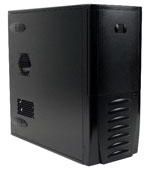 |
Our baseline recommendation has many similarities with the upgraded midrange configuration we used in our last buyers guide, including the use of the same 22" widescreen display from Acer and the Microsoft keyboard and mouse combo package. We have chosen a slightly different case and power supply, although the choice of case is going to be largely based on personal preference. The Antec SLK-3000 case is your classic steel Antec chassis with a black paint job: it's durable, easy to work with, and it includes a reasonably quiet rear 120mm fan with an additional 120mm fan mount at the front of the case. A second fan isn't absolutely required, but adding a lower RPM fan can help ensure that your components stay cool. As we are using multiple graphics cards in all the configurations, we felt a good-quality power supply was a required starting point. While just about any 500W or higher rated PSU is going to be sufficient, we wanted something relatively quiet that we were confident would last a long time.
(Ed: And we changed from the original PSU choice due to user feedback...) We selected the Seasonic S12-500 to go with the Antec case, as Seasonic is one of the most highly regarded PSU manufacturers around. 500W might seem low to some, but this is truly a 500W PSU with a high efficiency; it can really output 500W to all the peripherals - more than enough for the systems listed here today - and it will do so without drawing substantially more power from the outlet. We also added some basic 5.1 speakers from Logitech - something we omitted in the previous buyers guide.
(Ed: Sorry!) For the basic builds, we feel most users will be fine using integrated audio, so we are not listing a sound card, but you can see some options below.
| Upgraded High-End Case and Accessories |
| Display |
Acer 24" AL2416Wd 6ms 1920x1200 |
$686 |
| Case |
LIAN LI PC-7B plus II |
$100 |
| Power Supply |
OCZ GameXStream OCZ700GXSSLI 700W |
$130 |
| Keyboard and Mouse |
Logitech Keyboard and Mouse - Wireless + Rechargeable |
$56 |
| Sound Card |
Bluegears b-Enspirer |
$106 |
| Speakers |
Cyber Acoustics A-5640rb 5.1 |
$100 |
| Total |
$1178 |
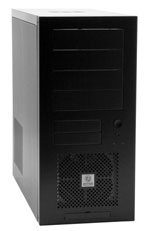 |
Stepping up one notch, we've moved up to a 24" LCD from Acer, sporting a native 1920x1200 resolution with a fast 6ms response time. With all the money spent on upgraded graphics cards, there's no point in not having a high-end display to help keep them busy! For the case, we chose the Lian Li PC-7B black aluminum enclosure. Lian Li has always been known for building high-quality cases, and this is no exception. Like the Antec we selected above, it includes two 120mm fan mounts at the front and rear of the case, only this time both fans are included. We upgraded the power supply one more notch to a 700W model, this time going with the OCZ GameXStream 700W as it is presently the lowest priced quality 700W PSU available. Thermaltake, Fotron Source, and several other manufacturers offer similar power supplies - in fact, most of these power supplies are simply tweaked Fotron Source designs, so if you can find one of those for less money there's little difference other than the name on the side of the PSU. For the input devices, we switched to a wireless Logitech keyboard and mouse, with the mouse including a recharging stand. Some people have other preferences as far as keyboards and mice go, so get what you're comfortable with.
 |
We've also upgraded the speakers, and we added a Bluegears b-Enspirer soundcard. A lot of you may not have heard of this soundcard yet, but it is definitely one to consider. It uses the new C-Media Oxygen HD CMI8788 audio chip and features real-time Dolby Digital and DTS encoding support. This is a great soundcard for anyone looking to put together an HTPC system, or anyone looking for better than integrated audio without the Creative Labs name. Feel free to upgrade the speakers to something better or use your home stereo system in order to take full advantage of this soundcard. If you're primarily concerned with gaming audio, the Sound Blaster X-Fi is still the better choice, but for light gaming and home theater use the Bluegears b-Enspirer is an excellent alternative.
| Upgraded #2 High-End Case and Accessories |
| Display |
Dell 2407WFP 24" 6ms GTG 1920x1200 |
$720 |
| Case |
Antec Performance I P180 |
$125 |
| Power Supply |
OCZ GameXStream OCZ700GXSSLI 700W |
$130 |
| Keyboard and Mouse |
Logitech MX3000 Wireless + Laser Mouse |
$63 |
| Sound Card |
Creative X-Fi XtremeMusic |
$114 |
| Speakers |
Logitech Z-5300e 5.1 |
$139 |
| Total |
$1291 |
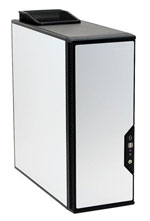 |
Most of the differences between this upgraded version and the previous upgraded version are slight. We've chosen the Dell 2407WFP 24" LCD, which we think looks a little bit nicer than the Acer, and it also includes a better stand and an integrated flash card reader. Are any of those changes required? No, but some of you will prefer the Dell display, and if you wait you might actually be able to find it for less money when Dell puts on one of their classic sales. We changed the case to an Antec P180, going for silver this time because not everyone likes black. (Make sure you get an appropriate optical drive faceplate if you choose this case!) The power supply remains the same, while we ditched the rechargeable wireless mouse for a wireless laser mouse. Finally, we upgraded the speakers another step to the Logitech Z-5300e. A little bit more money, a little bit better sound quality. We also chose a more gaming-centric sound card in the Creative Sound Blaster X-Fi XtremeMusic, which we would assume all of you are familiar with by now.
| Ultra High-End Case and Accessories |
| Display |
Dell 3007WFP 30" 11ms GTG 2560x1600 |
$1450 |
| Case |
Cooler Master Stacker 830 |
$243 |
| CPU Cooling |
Scythe Infinity |
$60 |
| Power Supply |
SilverStone SST-ST85ZF 850W |
$279 |
| Keyboard |
Microsoft Natural 4000 |
$43 |
| Mouse |
Logitech MX Revolution |
$90 |
| Sound Card |
Creative X-Fi Platinum |
$175 |
| Speakers |
Logitech Z-5500D 5.1 Digital Speakers |
$223 |
| Total |
$2563 |
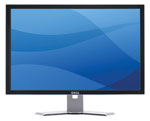 |
The Ultra accessories package is a great complement to the ultra high-end Intel configuration. In a similar fashion, we have maxed out just about every component, sometimes at significant expense. We have chosen the Cooler Master Stacker 830 for our top configuration, as it has a spacious interior and an attractive and easy to use design that's suitable for even the most high-end configurations. Yes, you could buy a different case, and as we often state what case is "best" is largely a matter of personal preference. For the display, the best computer deserves the best LCD currently available, so we have selected the Dell 3007WFP 30" LCD with a native 2560x1600 resolution (or WQXGA if you prefer). Definitely don't skimp on your GPU selection if you choose to go with this large monitor and plan on gaming at the native resolution!
We also jumped up to an 850W power supply from Silverstone, which costs almost twice as much as the 700W OCZ.
(Ouch!) However, with rumors circulating that the next generation high-end graphics cards from NVIDIA and ATI will
require even more power than the current models, we felt that any ultra high-end system needed a power supply equal to the task. (You could jump up to a PC Power & Cooling Turbo-Cool 1000W PSU if you really want to go extreme, but be prepared to fork over nearly $500 for the privilege!) The soundcard has been bumped up to the platinum edition of the X-Fi, which adds a 5.25" bay that provides front panel connections but is otherwise the same as the other X-Fi cards. For the speakers, we moved up to the Logitech Z-5500 digital speakers, eliminating the interference that can be generated by all of the electronic noise inside your computer case. Finally, for the user interface we went with Microsoft's Natural 4000 keyboard and coupled that with
Logitech's Revolution MX mouse, both of which are arguably best in class peripherals. However, personal preference still plays a role, so you might want to try out these devices in person at your local computer store.
CPU Cooling
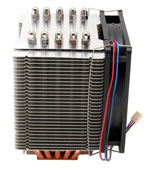 |
One item that we added to the ultra configuration that is worth considering for any of the system builds is an aftermarket heatsink to help keep your processor cool. If you are looking for the HSF that we currently feel is the best air cooling available, look no further than the Scythe Infinity. It is absolutely massive and definitely won't fit in every computer case out there - or on every motherboard - but if you are serious about overclocking then the $65 is money well spent. Another good alternative is the Tuniq Tower 120, which is unfortunately out of stock everywhere right now. We consider the Scythe Infinity to be the better CPU cooler, but the Tuniq Tower 120 is very good and might cost a bit less. Another competing solution (that's just as large as the Infinity) is the Thermalright Ultra-120, which typically equals the other two in cooling prowess and may cost a bit more or less depending on where you find it. For cases and motherboards that aren't quite as spacious, Zalman and Thermalright offer reasonably priced CPU coolers that will still outperform the stock heatsinks from both AMD and Intel.

















45 Comments
View All Comments
limiter - Thursday, October 19, 2006 - link
I purchased one of the MSI 975x Platinum Powerup boards and the Giel ram suggested in this article and I am having issues with boot up and reboots. I have the ram at DDR2-800, 2.4v (which is what my set says to set the voltage at). I tried setting memory timings to automatic and manually at 4-4-4-12 (again what the memory claims it's timings are). Sometimes the system hangs before post on reboot, sometimes from cold start it starts then resets over and over, sometimes it says "Overclocking failed" with no changes to the CPU settings (just memory). Sometimes it boots up just fine... when it does it works great. I have 7.1 of the bios (official release right now), and I have read that a lot of other people are having the same issues. Also you need a PS2 keyboard to make any bios changes which is annoying. Any suggestions from the Anandtech people?thart - Friday, October 13, 2006 - link
From: Terry Hart [mailto:tmhartsr@comcast.net]Sent: Thursday, October 12, 2006 11:41 PM
To: Baliff, Michael; Werder, Nick; Shade, Tom; Santos, Jim; Rice, Robbie; Pope, Jeff; Hart, Scott; Rose, Sam; Johnson, Ken
Subject: Stuff
Ken, etc.
Following links are to recent Anand Tech Recommendations for Mid Range and High End builds. I strongly disagree with their choices, especially for Mid Range.
1. The DDR-2 Memory has gone up in price and now costs considerably more than standard DDR. DDR-2 adds absolutely zero in performance to any AMD system. Therefore the best value by a considerable margin remains Socket 939 and standard DDR.
2. This Mad Rush to Dual Core is insane. There is practically zero difference in everyday performance. Almost no applications yet exist to really take advantage of it. A 1.8 GHz Athlon-64 3000 Single Core costs $55 for the retail box. The least expensive 2.0 GHz Athlon-64 3800 Dual Core costs $164.00 for the retail box. The actual difference in performance of these two is very small and certainly not worth 3 times as much!
3. The nVidia 6150 chipset based Micro Boards are the best I have ever seen. They include Gig Net, Firewire, SATA II 3.0, Raid, S Video Out, Dual Monitor support, splendid 7.1 Audio, and the best on-board Video anyone has ever seen. How one can possibly justify twice as much for the full size MOBO - plus another $100, or more, for a decent Video Card, is hard for me to understand.
4. These Rosewill Towers and Power Supplies cost a fraction of what Anand recommends. The Rosewill PS'es are just fine and the towers are the easiest to work in and have more bays than any of the ones they recommend, or that I have ever used before.
5. The NEC DVD Writers are great if you run only Doze. But they DO NOT work on any Linux system. Recently purchased a Retail Box NEC and received no cable(s) whatsoever, no DVD Software Decoder - just NERO 7 OEM. The Retail Box Lite-On DVD Writers with Lite-Scribe are better choices, I think.
6. Few folks need the Media Center OS. Only advantage I see is if you do install and use a Radio/TV Tuner/Capture card - which almost no one does. Not a thing wrong with plain old $89 Doze XP Home OEM for 99% of users. Nothing in the PRO Version that I need here either?
http://www.anandtech.com/guides/showdoc.aspx?i=283...">http://www.anandtech.com/guides/showdoc.aspx?i=283...
http://www.anandtech.com/guides/showdoc.aspx?i=285...">http://www.anandtech.com/guides/showdoc.aspx?i=285...
Sure wish someone would explain to me why I should spend well over 3 times as much for a Dual Core Socket AM2 than the more than adequate Socket 939 Single Core choices?
Terry
JarredWalton - Friday, October 13, 2006 - link
1 -- High-end DDR2-800 like the GEIL Ultra costs $280 for 2GB. High-end DDR-500 costs $250 minimum and comes with generally lower performance. AM2 is 5% faster on average compared to a similar 939 setup. DDR is a dead end, with the last batches being manufactured between now and January 2007. Does that mean you need to go out and upgrade from a DDR system to DDR2 system? Certainly not, but I definitely wouldn't save $30 to stick with an outdated platform if you're buying a new computer, which is the point of the buyer's guides.2 -- Obviously you have never run any serious multitasking applications. 3D rendering, video encoding, audio encoding, professional image editing, compression/decompression are all more than capable of utilizing more than a single processor core. If you never do anything more than surf the web, write e-mail, and use Microsoft office then you don't need dual cores right now.
3 -- Obviously you have never used a really good motherboard if you think the 6150 chipset is the best motherboard ever. Or more specifically, you are assuming that your needs are the same as everyone else's needs/wants. I don't even want to think about trying to run games on a 6150 chipset. Of course, we've already run benchmarks http://www.anandtech.com/showdoc.aspx?i=2553&p...">comparing ATI and NVIDIA integrated graphics. Think those numbers look impressive? A dual GPU configuration like those used in this article packs about 20 times more graphical performance, which can be very useful for high-quality gaming. I don't even want to think about running Oblivion on any integrated graphics chipset.
4 -- Rosewill is about is generic of a brand as you can get. While that might be okay for the cases, I would never recommend a $50 power supply for use in a system that costs well over $2000. I'm pretty sure you're convinced that every buyer's guide should be a budget buyers guide, but some people actually like to have the fastest computers available, and some of us actually make use of them.
5 -- Every motherboard I have ever purchased comes with IDE cables that can be used with your optical drive. Perhaps if you purchased the cheapest motherboards on the market, along with IDE hard drives, you might only get a single cable and find yourself in a difficult situation where you have to go out and spend an extra $4 on another cable? As far as whether or not they work with Linux, I can't say I've tested it, but I'm confused as to why they wouldn't work. Finally, you can get DVD software decoders for free if you need them.
6 -- Have you ever tried to share your various folders on the network using XP Home? Yes, you can share certain folders, but you can't simply share the whole hard drive, and you will never be able to access certain folders over the network. As I stated in the article, if you only run one computer in your house, he certainly won't notice the difference between XP Home and XP Professional. As for Media Center Edition, it has virtually all of the features of XP Pro plus a bunch of extras of its own, and it costs $30 less than XP Pro.
Why should you spend more money for dual core socket AM2 system? Well, if you had read this guide carefully, you would notice that I actually don't recommend buying the AM2 systems at all. For people that actually want maximum performance, Core 2 Duo has anything available from AMD beat hands down. Anyway, you obviously shouldn't go out and buy a high-end computer, because clearly you aren't doing anything that needs it.
I have actually been using a socket 754 system as my primary computer for the last two years, and only the last couple of months did I finally decide to migrate all of my work onto a faster system. Do I notice the difference in performance? You darn well better believe it! Not just in games either. I can do work in Photoshop much faster than before, especially when working with multiple images. But there are plenty of times when the system sits idle just waiting for me to give it something to do, and clearly at such times my new faster system is no better than my old system.
You might want to read the conclusion one more time, as it contains statements targeted directly at people like yourself: "The best time to upgrade is when you are no longer happy with your computer... or perhaps just after winning the lottery. Many of us still have computers that are over two years old that we use on a regular basis, and while they may not be the fastest systems on the planet, for a lot of tasks they are perfectly adequate."
I'm glad you're happy with your single core socket 939 system. Just because it's adequate doesn't mean that I should recommend it for anyone going out on purchasing a new computer today. Should someone with an old Celeron system upgrade to socket 939 right now? That would be a pretty pointless upgrade, considering that it doesn't cost much more money to change to something else that would be faster and more future proof. It would be like talking to someone who has an old 1970s car that they're finally going to get rid of, and recommending that they upgrade to a used car manufactured in 1995, because after all that's 25 years newer than their old piece of junk.... In fact, not only should they upgrade to a 1995 model, but they should pay $10,000, because that's a much better than paying $14,000 for a decent 2006 model car.
Regards,
Jarred Walton
Editor
AnandTech.com
yyrkoon - Saturday, October 14, 2006 - link
There are also a few other things that you cant do in XP home, such as run as a server, or run IIS, ect.Also, I'm not sure whether dual core CPU will be taken advantage of in XP home, although early versions of XP home wouldnt reconize Hyper Threading CPUs (they would only show in the device manager as a single CPU, where in XP pro, they would show as dual CPUs), they have since 'fixed' this, but I havent played in XP home for a very long time, so I can not be sure. Reguardless, 'real' dual CPUs wont be taken advantage of in XP home.
As Jarred pointed out, more than 'simple file sharing' is not supported in XP home, which may be fine for the casual user, but I think we all can agree the majority of the people reading these comments are not the average user. File permissions also are not as flexable as in XP pro (if availible at all), which in certain situations, can be a big deal.
There are probably a few things I've missed, but whatever, you get the point.
yyrkoon - Friday, October 13, 2006 - link
Hey Jarred, I'd like to add, that I'm currently using a Asrock AM2NF4-SATA2 board, and as a test, I installed XP, etc, and PLAYED Oblivion on the onboard 6100 graphics . . .Needless to say, I ordered a 7600GT from newegg . . . as even @ 800x600 low settings, the system wouldnt play the game faster than 12 FPS, and gameplay was terrible. Hell, my old 3200+ XP system with a 6600GT spanked the crap out of it. Now, Im getting ATLEAST a steady 30 FPS, and the game plays much, much smoother.
yyrkoon - Friday, October 13, 2006 - link
No one said you HAD to spend ANYTHING. This article wasnt written for YOU specificly. I basicly took it as a 'guidelines' article myself.1. My AMD 3800+ AM2 system gets 3 times as much menmory bandwidth comparred to my AMD 3200+ XP system
2. Rush, or not, no one SAID yo uhad to.
3. The nVidia micro 6150 boards are fine IF you dont care about the latest features used in current chipsets, and are ALL budget boards that dont always run 100% stable, even when set 100% stock (I know because I've built a few, and am replying from one right now)
4. Rosewill PSUs . . . hah. thats about all thier good for, is a laugh.
5. I think its fiarly safe to say that 95% of people who use cutting edge systems, dont use Linux, period, atleast, not for desktop system.
6. Here, we're talking ENTHUSIAST, do you think an enthusiast is going to be using XP home ? I know I wouldnt.
Single core wont multitask any hwere near as well as a dual core system, but hey, feel free to live in the dark ages, if you so feel the need, hell I have a friend who thinks its evil to install SP2 on XP, and refuses to upgrade past his P3 pentium, but, whatever floats your boat, no need to TRY and make someone feel bad about thier article because YOU dont agree with it. See ya *wave*
AaronAxvig - Tuesday, October 10, 2006 - link
If I really wanted a high end, no holds barred machine, I could spend way more than you did ($10,000+). For sure I'd go with 15k SCSI drives, RAIDed however to eke the most performance out. And then, I probably WOULD go off the deep end and get the dual-socket motherboard, because guess what: games are going to start using 4 cores (Alan Wake gets thrown around a lot here).JarredWalton - Tuesday, October 10, 2006 - link
The thing is, the Alan Wake demo ran on an overclocked QX6700 and then they even stated that it would run just as fast at stock speeds. Translation: it didn't need faster quad cores. The next big question then becomes: how much does it really need quad cores over dual cores? I will wager it ends up being heavily GPU limited on dual-core systems, and quad core will only make a difference with 2 x G80/R600 or at lower resolutions. No one buying a $4000+ system is going to run at anything less than 1600x1200/1680x1050 if they can avoid it.Obviously, you can go higher than the $5600 system. We don't generally recommend even $5000 systems for the majority of people, and the number of people that should get a $10K PC is very small. I'd never put 2x15000 RPM drives in a home computer... high pitched whine, need for extra fans to keep the case cool, etc. means it's solely for bragging rights and not much else. Funny thing is, in most consumer oriented benchmarks a RAID 0 SATA setup is going to pretty much match RAID 0 SCSI. Most tasks simply aren't HDD I/O bound... and if they are, add more RAM!
Justin Case - Tuesday, October 10, 2006 - link
Why are clock speeds given for the AMD CPUs, but only model numbers for the Intel CPUs...?I don't remember Anandtech having any problem publishing AMD's clock speeds back when they were lower than Intel's (even though the CPUs were actually faster). So now that the situation is reversed (Intel has better IPC, but their CPUs' frequency is about the same), why the sudden omission of Intel's clock speeds (and just a reference to "you might get 3 GHz with overclocking")?
Could it be because Chipzilla's marketing department sent its minions^H^H^H I mean "favourite journalists" a memo telling them to join in on the model number campaign or kiss their free preview samples goodbye? Nah, that couldn't possibly be it....
JarredWalton - Tuesday, October 10, 2006 - link
Absolutely not! It's merely a matter of me forgetting to put the clock speeds in on the Intel chips. Trust me, when you're trying to hammer out the last bits and pieces of of the 7000 word article, put together the tables, and get everything posted before 8 a.m. Eastern time thing slip through the cracks. :-) I will go in update the tables now....